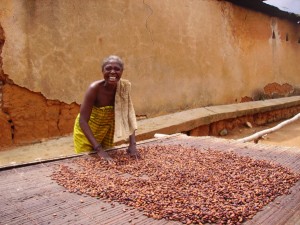Originally published at CIRAD
Cocoa agroforests are complex agrosystems similar to natural ecosystems. That complexity is an asset in terms of managing cocoa pests and diseases. But how does it serve to regulate their presence and minimize the intensity of their attacks? Based on studies in Cameroon and Costa Rica, researchers from CIRAD and their partners recently demonstrating the predominant role of the spatial structure of such agroforests in terms of regulation.

Cocoa is one of the few plants still grown traditionally in agroforests in most producing countries. These cocoa agroforests are agro-ecosystems characterized by the substantial biodiversity of their vegetation, and also by considerable heterogeneity in terms of the spatial structure of their vegetation.
That complex structure makes them “similar” to natural ecosystems and enables them to render a range of ecosystem services. But what about pest and disease management? In other words, does that complexity influence the presence of cocoa enemies and the intensity of their attacks?
To answer that question, researchers from CIRAD and their partners studied cocoa agroforests in Costa Rica and Cameroon.
Composition and spatial structure of agroforest plots
The researchers monitored three cocoa pests in particular, chosen for their contrasting spread and development characteristics.
In Costa Rica, they looked at frosty pod disease, caused by a fungus, Moniliophthora roreri,in a network of plots set up in the Talamanca region.
In Cameroon, they observed black pod disease, caused by another fungus, Phytophthora megakarya, and mirids, bugs of the species Sahlbergella singularis that damage trees by feeding.
They began by describing the spatial structures of cocoa agroforests and building typologies. This enabled them to distinguish between different horizontal spatial structures, ranging from regular to clustered shade tree distribution.
The researchers went on to identify and rank, on an agroforest plot scale, the composition and spatial structure characteristics that affect the intensity of frosty pod disease attacks in Costa Rica and black pod and mirid attacks in Cameroon.
Regular tree distribution reduces attacks
This revealed the predominant role of the spatial structure of the plant stand in regulating pests and diseases.
In Costa Rica, frosty pod intensity increased the more the forest trees were clustered. In Cameroon, black pod incidence increased with the density of the understorey in the plot, and mirid attacks were less frequent the more regularly the shade trees were distributed.
These results can be put down to the numerous mechanisms that link vegetation structure to pests and diseases and the characteristics of those pests and diseases.
An initial step towards understanding natural pest and disease regulation
This study provided an accurate description of the structure of complex tropical agro-ecosystems and of the relations between the structures observed and pest and disease regulation.
As part of an agro-ecological crop management approach, it was an initial step towards identifying and understanding the ecological mechanisms involved in natural cocoa pest and disease regulation on a plot scale.











